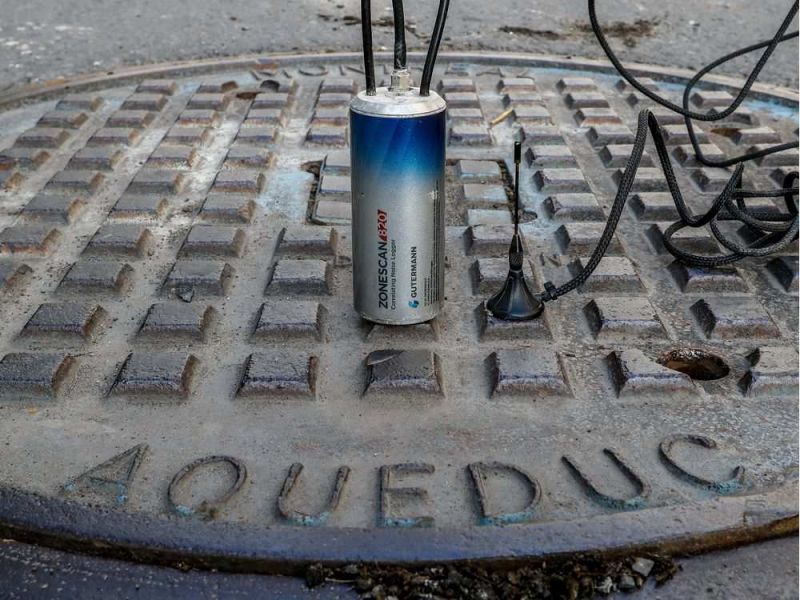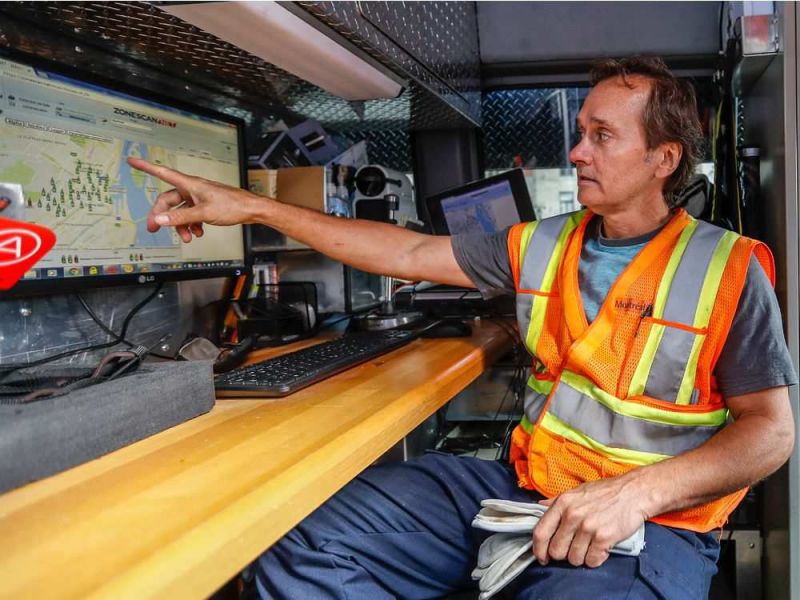$1.1-million System in Montreal Listens for Leaks
Published on by Water Network Research, Official research team of The Water Network in Technology
Every day at 2 a.m., hundreds of probes installed under Montreal streets come to life in order to check for leaks.
 About the size of soft drink cans, they turn themselves on, record sounds for 30 seconds, then use attached antennas to beam the audio files to cellphone towers.
About the size of soft drink cans, they turn themselves on, record sounds for 30 seconds, then use attached antennas to beam the audio files to cellphone towers.
They, in turn, send the audio on a 6,000-kilometre trip to a control centre in Germany.
Sitting in front of a computer in a white city truck in Old Montreal late one morning in October, Denis Labbé scans Montreal’s leaky underbelly.
He clicks on a red dot on a map of Old Montreal on a German website.
A red dot means trouble: a water-main may be losing water.
About 30 per cent of the water that flows through Montreal’s crumbling water-main network is lost due to leaks, an improvement from the early 2000s, when 40 per cent was being wasted.
Though the city is spending millions to replace 54 kilometres of water mains annually, the rate remains high.
Montreal started getting serious about plugging damaged water mains in 2013 when four two-person teams began criss-crossing the city, on the hunt for faulty conduits.
Their aim is to locate leaks when they are small. It can take months or years for evidence of a problem pipe to reach the surface. Patching holes before that happens reduces water wastage and the risk of pricier repairs, flooding, sinkholes and longer road closures.
The city crews listen for sound anomalies by placing specialized microphones on fire hydrants (Montreal has 22,600 of them). When technicians detect noise that could signal water loss, they make a note and move on.
“They’ll scan all the fire hydrants in one sector and then go back and do the correlation to pinpoint the leak,” said Normand Hachey, head of strategic asset management for Montreal’s water and waste water networks.
“A leak makes a high-pitched sound, and it has to be a constant sound. There are some sounds that will come and go but a leak will stay.
“Leak detection is an art and a science,” Hachey added. “People who do leak detection have to develop an ear to be able to distinguish between sounds.”
 Leak-detection teams use computers that analyze sounds detected on two spots on the network — two fire hydrants, for example, or a fire hydrant and a valve.
Leak-detection teams use computers that analyze sounds detected on two spots on the network — two fire hydrants, for example, or a fire hydrant and a valve.
An electronic “correlator” device gives an estimated location using sounds from either side of water seepage, as well as with information entered by technicians (the length and diameter of the pipe, and whether it’s made of cast iron, ductile iron or PVC).
Then, the city workers use specialized ground microphones to pinpoint the location of leaks to within about a meter.
The crews probe 80 per cent of the network every year, in some cases going back to reassess areas where water mains are older, and to specific water mains that are prone to leaks.
Last year, they uncovered almost 400 broken water mains.
But this technique isn’t ideal on downtown streets and in Old Montreal because of extraneous noise — from traffic, construction, electrical transformers, natural-gas lines and private water pumps for high-rises. Technicians also waste time in traffic and searching for parking in these areas.
Which brings us back to the city van in Old Montreal.
After reviewing the information on his computer screen, Labbé, Montreal’s chief technician in charge of systematic leak detection, and co-worker Alain Charbonneau walk to the middle of Place Royale, near de la Commune St. They put up orange cones and use a pickaxe to pull off a manhole cover. Down in the hole, a defective valve is spewing out a steady stream of water.
The hole confirmed, a report will be sent to the borough so it can be fixed.
The website the city crew is using is part of a new, more sophisticated leak-detection system targeting 46 kilometres of water mains in a 12-square-kilometre area of downtown and Old Montreal.
The city finished installing the $1.1-million system in March.
It focuses on a subsection of the 34,000 valves the city uses to control or stop water flow in specific sections to allow for repairs and other work.
At the system’s core are 700 leak detectors installed on valves located in enclosed areas, often under manhole covers.
Known as loggers, the devices record audio every morning. Attached to the loggers are antennas that send the recordings to a repeater on a nearby post. From there, the information is relayed to the cellular-phone network, which is used to transmit the data to the company that makes the technology, Gutermann, in Germany.
It’s then posted on a website accessible to Montreal technicians.
Read full article at: Montreal Gazette
Media
Taxonomy
- Technology
- Smart Meters
- Integrated Urban Water Management
- Smart City
- Leakage Detection
- Leakage
- Integrated Infrastructure
- Pipes and Pipelines